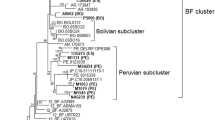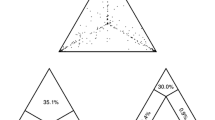Human polyomavirus JC virus (JCV) isolates around the world are classified into more than 10 geographically distinct genotypes (designated as subtypes). Evolutionary relationships among JCV subtypes were recently examined, and the following pattern of JCV evolution was indicated. The ancestral JCV first divided into three superclusters, designated Types A, B, and C. A split in Type A generated two subtypes, EU-a and -b, containing mainly European and Mediterranean isolates. The split in Type B generated Af 2 (the major African subtype), Bl-c (a minor European subtype), and various Asian subtypes. Type C generated a single subtype (Afl), consisting of isolates derived from western Africa. In this study, JCV isolates prevalent among northeastern Siberians and Canadian Inuits were evaluated in the context of the above-described pattern of JCV evolution. The Siberian/Arctic JCV isolates were classified as belonging mainly to Type A, based on the result of a preliminary phylogenetic analysis. We then examined, using the whole-genome approach, the phylogenetic relationships among worldwide Type A isolates. In neighbor-joining and maximum-likelihood analyses, Type A JCVs worldwide consistently diverged into three subtypes, EU-a, -b, and -c, with high bootstrap probabilities. EU-c was constructed only by northeastern Siberian isolates, derived mainly from Nanais living in the lower Amur River region, and was shown to have been generated by the first split in Type A. Most Siberian/Arctic isolates derived from Chukchis, Koryaks, and Canadian Inuits formed a distinct cluster within the EU-a subtype, with a high bootstrap probability. Based on the present findings, we discuss ancient human migrations, accompanied by Type A JCVs, across Asia and to Arctic areas of North America.
Similar content being viewed by others
Author information
Authors and Affiliations
Rights and permissions
About this article
Cite this article
Sugimoto, C., Hasegawa, M., Zheng, HY. et al. JC Virus Strains Indigenous to Northeastern Siberians and Canadian Inuits Are Unique But Evolutionally Related to Those Distributed Throughout Europe and Mediterranean Areas . J Mol Evol 55, 322–335 (2002). https://doi.org/10.1007/s00239-001-2329-2
Received:
Accepted:
Issue Date:
DOI: https://doi.org/10.1007/s00239-001-2329-2




